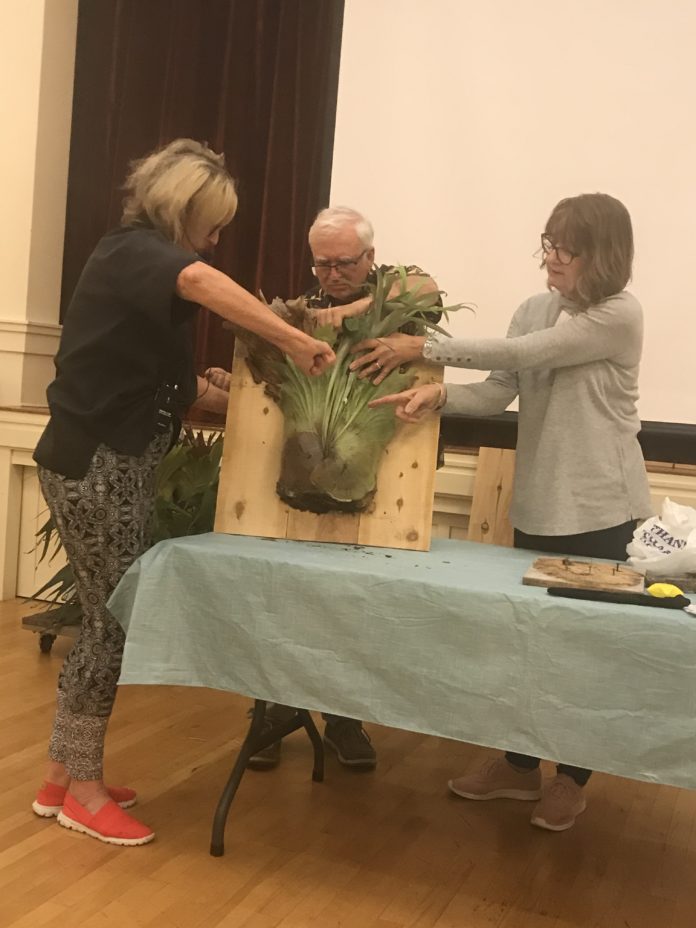Staghorn Ferns
Lynn Walker-Beveridge gave the Mission Hills Garden Club a practical and interesting approach to staghorn ferns. She began her talk with the basics giving us specific and easy to follow instructions on propagating and nourishing staghorn ferns.
Walker-Beveridge began by showing us several plants that Martha Pehl had grown. They ranged in age from two to four years old. Walker-Beveridge showed us how to mount a fern on a board. Because they propagate rapidly, they quickly become quite heavy. This means the board or backing must be able to bear the weight of the plant. Typically, the staghorn sits vertically against a board. It is wired to the board, which is then suspended from a sturdy tree branch or nailed to the side of a building or fence.
It is not necessary to pay a fortune for a new staghorn fern. If you have a friend with a mature plant, ask if you could have a few cuttings, or pups. These come from the base of the mother plant or from the sides of it. Walker-Beveridge likes to use a curved linoleum knife, but she has used a regular butcher’s knife. Babies may be planted in pots filled with pure peat moss. Larger pups may be mounted on a board or in a basket on top of a bed of sphagnum moss.
Walker-Beveridge likes to use a one-inch thick board about one foot by one foot. Mount the plant slightly below the base’s center. Some people draw a circle showing where the plant will be placed. Next you will place six nails (or screws with an eye) evenly distributed just inside the periphery of the circle. Walker-Beveridge secures the plant using heavy monofilament nylon fishing line (30 to 60 pound test) wrapping the line around the nail or screw and then pulling the line taut and across the plant to a nail on the plant’s opposite side. As you weave your line back and forth and up and down maintaining a constant pressure to hold the plant securely, stuff mounds of wet sphagnum moss about an inch and a half deep behind each shield.
Although Walker-Beveridge warned us to avoid nailing through the shield or the root ball, her brother-in-law deliberately drives his nails or screws into the plant. They don’t seem to mind.
Mounting your staghorn is typically a two or even three person job. One person will hold the plant and board in place while the other wraps the line around it. Avoid mounting your fern against a stucco wall as it will adhere to the stucco and probably damage it before you notice.
Your newly mounted plant will enjoy our mild climate, but keep it away from direct sunlight. A bright location is best to keep the leaves from burning. If you live in an area of frost or snow, you should cover the plant with canvas or some sort of protection from freezing.
Staghorn ferns are not picky. If you feed them once a month during spring and summer and every other month in fall and winter, your plants should thrive. Walker-Beveridge likes to use an evenly balanced water-soluble fertilizer (ratio 1:1:1) or fish emulsion. Martha Pehl uses Gro Power tablets, one tablet dissolved in water monthly. Walker-Beveridge’s staghorns love a banana peel slipped behind the shield frond. She says mature staghorns can survive being fed twice a year. Feed and water from the top. Excess water will run down and out keeping the plants root system from rotting.
According to Walker-Beveridge, there are basically only two ways to kill a staghorn fern: too much water or not enough water. How much light, humidity and heat will determine your watering schedule. If antler fronds turn brown or black at the base, they are receiving too much water. If the fronds wilt or turn brown at the tips, they need more water. They enjoy being misted, even if they don’t need water. When the weather is hot and dry, weekly watering should suffice. During cooler months they may be content with water once every two or three weeks.
I am sorry to report that I did mount a staghorn fern and hung it in bright but indirect light. It exhibits none of the symptoms mentioned above, but it looks as I did after spending four hours working in the hot sun in the canyon. It is just limp and looks quite ill.
More exciting news! Garden Walk 2020 is set for Saturday June 27. We will stroll through/by 10 gardens while abiding by all current COVID 19 safety recommendations set by our local officials.
Tickets are available at https://www.missionhillsgardenclub.com/Garden-Walk and are being sold before start time to prevent crowding.
If you would like to attend the walk for free – sign up to be a garden greeter. We are in need for more greeters; so please share with your friends. Contact Martha Pehl at programs@missionhillsgardenclub.org. For more information, visit www.missionhillsgardenclub.org.

Category: Education, Events, Gardening, Local News, Nonprofit







